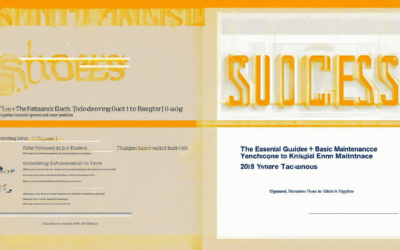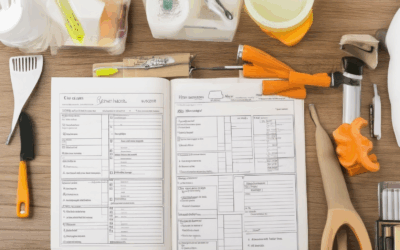House repairs can be unpredictable and costly if left unchecked, which makes it essential for homeowners to stay proactive with house repair essentials. Whether it’s addressing leaks, fixing electrical issues, or maintaining appliances, having the right tools and knowledge is crucial. This comprehensive guide dives into the most common home repairs, essential tools every homeowner should have, and practical maintenance tips to prevent costly breakdowns. By understanding the 1% rule for home maintenance and creating a personalized checklist, you can ensure your property stays in top shape. From budget-friendly solutions to leveraging technology, this article covers everything you need to keep your home in excellent condition. Stay ahead of unexpected repairs and enjoy peace of mind with our detailed insights into house repair essentials.
Key Takeaways
– Prevent Hidden Damage: Regularly inspect pipes, HVAC systems, and gutters to catch issues early and avoid costly repairs.
– Boost Efficiency: Clean and maintain HVAC systems to ensure optimal performance and energy efficiency.
– Protect Against Water Damage: Keep gutters clear and check for leaks in pipes and fixtures.
– Extend Home Life: Perform routine checks on appliances, electrical systems, and fire safety features to ensure reliability.
– Save Money: Use the 1% Rule to budget for annual maintenance, preventing minor issues from becoming major problems.
– Stay Organized: Use a maintenance checklist to track tasks, ensuring nothing is overlooked.
– Enhance Curb Appeal: Maintain exteriors, decks, and landscaping to keep your home looking its best.
– Secure Your Space: Inspect foundations, chimneys, and security systems to protect your family.
– Ensure Healthy Living: Regularly service water heaters and clean attics to promote fresh air and reduce moisture issues.

Most Expensive Home Repairs
The most expensive repairs on a house often involve major structural components or extensive damage requiring extensive work. Here are some of the most costly repairs:
- Structural Damage Repairs : Foundation issues, such as cracks or rot, can be extremely costly. Repairing or replacing a damaged foundation typically ranges from $10,000 to $30,000+
- Roof Replacement : Replacing an old or damaged roof, especially with asphalt shingles, can cost between $8,000 to $15,000+
- Water Damage Restoration : Fixing widespread water damage, including mold removal and structural drying, can cost upwards of $10,000+
- Electrical System Overhaul : Major rewiring or upgrading electrical systems can exceed $20,000+
- Plumbing Repairs : Replacing old pipes or fixing severe leaks can cost between $5,000 to $15,000+
- Appliance Replacement : Installing new HVAC systems, refrigerators, or ovens can range from $4,000 to $20,000+
- Landscape Structural Repairs : Repairing or replacing retaining walls, patios, or decks can cost $10,000 to $25,000+
- Interior Renovations : High-end kitchen or bathroom remodels can easily surpass $50,000+
- Exterior Resurfacing : Replacing or resurfacing driveways, walkways, or pool decks can cost between $10,000 to $30,000+
Structural repairs, particularly to foundations and roofs, tend to be the most expensive due to their critical nature and the potential scope of the work required. Regular home inspections and timely repairs can significantly reduce the risk of costly damages over time.
Essential Tools Every Homeowner Should Have
Keeping a home in tip-top shape requires the right tools. Here’s a curated list of must-have items for every homeowner:
- Multi-Purpose Tool Set : Essential for fixing leaks, tightening screws, and managing small electrical issues.
- Basic Hand Tools : Includes a screwdriver, adjustable wrench, utility knife, and pliers for versatile use.
- Home Security Tools : A high-quality lock set with deadbolts, door locks with combination options, and a simple surveillance camera system.
- Garden & Yard Tools : Lawn mower, pruning shears, rake, and a wheelbarrow for efficient yard maintenance.
- Household Necessities : Measuring tape, level tool, drill, and impact driver for home projects and repairs.
- Cleaning Supplies : Vacuum cleaner, mop, and broom, along with a pressure washer for tough cleaning tasks.
- Electrical Safety Tools : Circuit breaker, GFCI outlet, smoke detector, and carbon monoxide alarm.
- Water Management Tools : Water heater thermostat, sump pump, and water filtration system.
- Storage Solutions : Shelving units and cabinets for organizing tools and household items.
- First Aid & Emergency Kit : Well-stocked first aid kit and emergency preparedness kit with flashlights and blankets.

Most Common Home Repairs
The most common home repairs vary by property type and individual needs, but several issues frequently arise due to normal wear and tear or unexpected damage. Here’s a breakdown of the typical repairs homeowners encounter:
- Plumbing Issues : Leaky pipes, clogged drains, and malfunctioning water heaters are among the most frequent repairs.
- Electrical Problems : Faulty circuit breakers, dead outlets, and lighting fixture issues require attention.
- Heating, Ventilation, and Air Conditioning (HVAC) : Heating systems failing, air filters needing replacement, and ductwork issues are common concerns.
- Exterior Repairs : Roof leaks, fence damage, and gutter problems are prevalent in many homes.
- Appliance Malfunction : Refrigerators, dishwashers, and laundry machines often need repairs or servicing.
- Foundation Cracks : Small cracks in the foundation can indicate underlying structural issues.
- Landscaping and Yard Work : Fixing fences, installing sprinklers, and lawn care are routine tasks.
- Window and Door Repairs : Broken windows, stuck doors, and damaged screens require immediate fixes.
- Painting and Wall Repairs : Patching holes, touching up peeling paint, and repairing drywall are common tasks.
- Electrical Wiring : Upgrading or rewiring older systems to meet modern safety standards is often necessary.

What Routine Maintenance Is Required for a House?
Keeping your house in great shape requires regular maintenance to prevent issues before they arise. Here’s a detailed guide to essential routines:
-
Check for Leaks and Damage
- Inspect pipes, faucets, and hoses for cracks or leaks.
- Test for water pressure issues and ensure all fixtures function properly.
- Examine windows and doors for damage or gaps.
-
Clean and Maintain HVAC Systems
- Change air filters monthly to ensure efficient heating and cooling.
- Schedule professional inspections for your furnace, boiler, or AC unit twice a year.
- Clear debris from vents and ductwork to improve airflow.
-
Gutter and Downspout Cleaning
- Clear out leaves, debris, and clogs in gutters and downspouts.
- Ensure water flows freely to prevent basement flooding or foundation issues.
-
Exterior Maintenance
- Inspect and repair wood decks, fences, and outdoor structures.
- Check for peeling paint and repaint surfaces as needed.
- Trim trees and bushes to maintain proper spacing and prevent damage.
-
Kitchen and Bathroom Fixtures
- Regularly clean and lubricate appliances like dishwashers and garbage disposals.
- Check for loose handles or faulty connections under sinks.
- Replace worn-out gaskets and seals in fixtures.
-
Electrical Systems
- Test smoke detectors and carbon monoxide alarms monthly.
- Inspect electrical outlets and switches for signs of wear or damage.
- Ensure all wiring is secure and free from fraying.
-
Appliance Care
- Clean and maintain major appliances like refrigerators, ovens, and washing machines.
- Scheduled maintenance for items like lawn mowers and other equipment.
- Check expiration dates on medications and food storage containers.
-
Fire Safety Checks
- Inspect fire extinguishers for proper functioning and expiration dates.
- Ensure chimneys and flues are clean and free from blockages.
- Check for fire hazards like overloaded circuits or poorly placed rugs.
-
Landscaping and Yard Care
- Prune trees and shrubs to maintain healthy growth patterns.
- Mow and edge lawns regularly to prevent overgrowth.
- Inspect for pests like ants, spiders, and rodents in the yard.
-
Foundation and Driveway Inspection
- Look for cracks or unevenness in the foundation.
- Check driveway surfaces for potholes or damage.
- Seal cracks or gaps to prevent water seepage.
-
Water Heater and Plumbing
- Flush hot water tanks monthly to prevent sediment buildup.
- Check for slow draining in sinks and toilets.
- Inspect for leaks under sinks and around pipe connections.
-
Attic and Basement Maintenance
- Inspect attics for pests, moisture, and structural issues.
- Check basements for leaks, mold, or mildew.
- Ensure storage areas are organized and secure.
-
Security Systems
- Test alarm systems and cameras to ensure functionality.
- Update passwords and codes periodically.
- Inspect locks and entry points for security.
What is the 1% Rule for Home Maintenance?
The 1% rule for home maintenance is a simple yet effective strategy to ensure your property stays in great shape. Here’s how it works:
1. **Calculate Your Annual Maintenance Budget**: Start by determining 1% of your home’s purchase price. This percentage should be set aside annually for routine maintenance tasks.
2. **Examples of Home Maintenance Needs**: – **HVAC Systems**: Regular check-ups, filter changes, and tune-ups. – **Plumbing**: Leaky pipes, water heater inspections, and replacements. – **Roofing**: Annual inspections and minor repairs. – **Landscaping**: Lawn care, tree trimming, and gutter cleaning. – **Appliances**: Refrigerator, washer, dryer, and dishwasher maintenance or replacement.
3. **Why the 1% Rule Matters**: – Prevents small issues from becoming big problems. – Ensures your home remains safe and functional. – Saves money by addressing issues before they escalate.
By following the 1% rule, you’re taking a proactive approach to maintaining your home. This small investment each year can lead to significant savings and peace of mind in the long run.
For more tips and resources on home maintenance, visit our website . Looking for alternatives? Check out HomeAdvisor or Fixer Upper for additional maintenance insights.

What is a Maintenance Checklist?
A maintenance checklist is a structured guide used to ensure routine tasks are performed consistently and effectively. It typically outlines specific steps, actions, and procedures necessary to maintain equipment, systems, or property in optimal condition. Below is a breakdown of its key components and benefits.
Key Components of a Maintenance Checklist
- Task List: Detailed steps or actions to be completed during the maintenance.
- Frequency: How often each task should be performed (daily, weekly, monthly, etc.).
- Tools Required: Items needed to perform the tasks (e.g., wrenches, gauges, cleaning supplies).
- Sign-offs: Space for signatures or names to confirm tasks have been completed.
- Date and Time: Fields to record when maintenance was last performed.
Common Maintenance Checklists
Maintenance checklists vary depending on the type of system or property being maintained. Here are a few common examples:
- HVAC Systems: Air filters, coils, and ducts inspection.
- Appliances: Refrigerator, washer, and dryer checks.
- Vehicles: Oil changes, tire pressure, and fluid levels.
- BUILDINGS: Roof inspections, plumbing checks, and electrical systems.
Tools Needed for Maintenance
- Wrenches and screwdrivers
- Gauges and measurement tools
- Cleaning supplies and safety gear
- Replacement parts and lubricants
Conclusion
A well-organized maintenance checklist ensures that no detail is overlooked, helping to extend the lifespan of your equipment and systems. Regular maintenance not only prevents costly repairs but also contributes to overall productivity and safety. Always refer to manufacturer guidelines and local regulations when performing maintenance tasks.




0 Comments